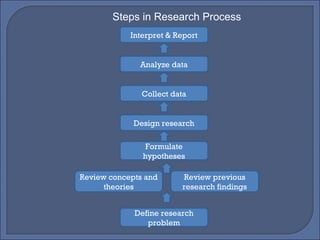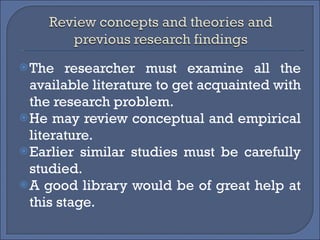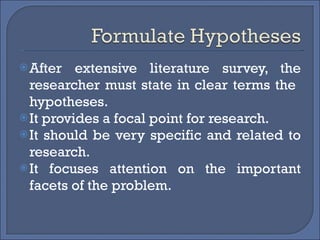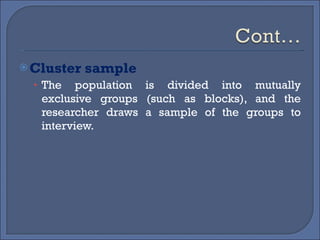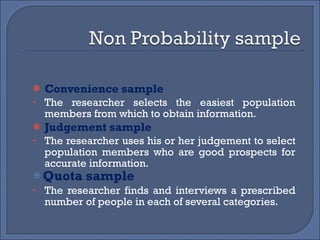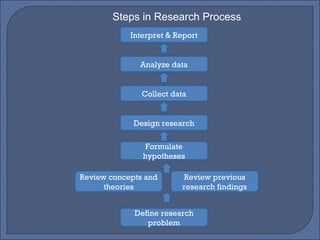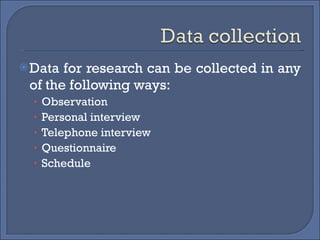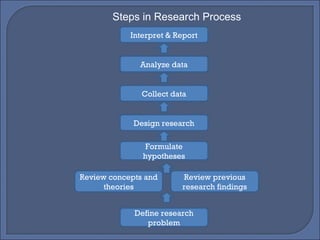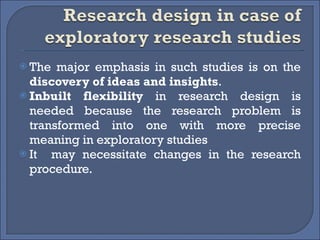Rm 4
- 1. Lecture 4 Farha Hassan
- 2. Define research problem Review previous research findings Review concepts and theories Formulate hypotheses Design research Collect data Analyze data Interpret & Report Steps in Research Process
- 3. Define research problem Review previous research findings Review concepts and theories Formulate hypotheses Design research Collect data Analyze data Interpret & Report Steps in Research Process
- 4. The researcher must single out the problem he has to study. He must decide the general area or subject matter he wants to enquire. Two steps are involved in formulating a research problem: Understanding the problem. Rephrasing the same into meaningful term from analytical point of view.
- 5. Define research problem Review previous research findings Review concepts and theories Formulate hypotheses Design research Collect data Analyze data Interpret & Report Steps in Research Process
- 6. The researcher must examine all the available literature to get acquainted with the research problem. He may review conceptual and empirical literature. Earlier similar studies must be carefully studied. A good library would be of great help at this stage.
- 7. Define research problem Review previous research findings Review concepts and theories Formulate hypotheses Design research Collect data Analyze data Interpret & Report Steps in Research Process
- 8. After extensive literature survey, the researcher must state in clear terms the hypotheses. It provides a focal point for research. It should be very specific and related to research. It focuses attention on the important facets of the problem.
- 9. Define research problem Review previous research findings Review concepts and theories Formulate hypotheses Design research Collect data Analyze data Interpret & Report Steps in Research Process
- 10. The conceptual structure in which the research would be conducted. The function of research design is to provide for the collection of relevant evidence with minimal expenditure of effort, time and money.
- 11. Research design would state the following: The means of obtaining information Time available for research Cost factor Determination of population and sample Sample size Sampling plan
- 12. This calls for three decisions— Sampling unit Who is to be surveyed? Sample Size How many people should be surveyed? Sampling Procedure How should the respondents be chosen?
- 13. Probability sample Simple random sample Stratified random sample Cluster sample Non Probability sample Convenience sample Judgement sample Quota sample
- 14. Simple random sample Every member of the population has a known and equal chance of selection. Stratified random sample The population is divided into mutually exclusive groups (such as age groups), and random samples are drawn from each group.
- 15. Cluster sample The population is divided into mutually exclusive groups (such as blocks), and the researcher draws a sample of the groups to interview.
- 16. Convenience sample The researcher selects the easiest population members from which to obtain information. Judgement sample The researcher uses his or her judgement to select population members who are good prospects for accurate information. Quota sample The researcher finds and interviews a prescribed number of people in each of several categories.
- 17. Define research problem Review previous research findings Review concepts and theories Formulate hypotheses Design research Collect data Analyze data Interpret & Report Steps in Research Process
- 18. Data for research can be collected in any of the following ways: Observation Personal interview Telephone interview Questionnaire Schedule
- 19. Define research problem Review previous research findings Review concepts and theories Formulate hypotheses Design research Collect data Analyze data Interpret & Report Steps in Research Process
- 20. It involves coding, tabulating and drawing out statistical inferences. Data is condensed into manageable groups and tables for managerial interpretation. Computers and other softwares are used widely for the purpose. Various statistical tests could be used.
- 21. Define research problem Review previous research findings Review concepts and theories Formulate hypotheses Design research Collect data Analyze data Interpret & Report Steps in Research Process
- 22. After testing a hypotheses several times, the researcher can arrive at a generalization and build a theory. Interpretation is a process whereby the researcher explains his findings on the basis of some theory. Finally the researcher has to prepare a report on what has been done by him.
- 23. Decisions regarding what, where, when, how much, by what means concerning an inquiry or a research study constitute a research design. “ A research design is the arrangement of conditions for collection and analysis of data in a manner that aims to combine relevance to the research purpose with economy in procedure.” The research design is the conceptual structure within which research is conducted; it constitutes the blueprint for the collection, measurement and analysis of data. An outline of what to be done from writing the hypothesis to the final analysis of data.
- 24. What is the study about? Why is the study being made? Where will the study be carried out? What type of data is required? Where can the required data be found?
- 25. What periods of time will the study include? What will be the sample design? What techniques of data collection will be used? How will the data be analysed? In what style will the report be prepared?
- 26. The Sampling design which deals with the method of selecting items to be observed for the given study. The Observational design which relates to the conditions under which the observations are to be made.
- 27. The Statistical design which concerns with the question of how many items are to be observed and how the information and data gathered are to be analysed. The Operational design which deals with the techniques by which the procedures specified in the sampling, statistical and observational designs can be carried out.
- 28. A good design is often characterised by adjectives like flexible, appropriate, efficient, economical, etc The design which minimises bias and maximises the reliability of the data collected and analysed is considered a good design. The design which gives the smallest experimental error is supposed to be the best design in many investigations. A design which yields maximal information and provides an opportunity for considering many different aspects of a problem is considered most appropriate and efficient design in respect of many research problems.
- 29. The major emphasis in such studies is on the discovery of ideas and insights . Inbuilt flexibility in research design is needed because the research problem is transformed into one with more precise meaning in exploratory studies It may necessitate changes in the research procedure.
- 30. The researcher must be able to define clearly what he wants to measure and must find adequate methods for measuring it. There has to be a clear cut definition of ‘population’ he wants to study. The procedure to be used must be carefully planned.
- 31. The research design must make enough provision for protection against bias. The design in such studies must be rigid .
- 32. Formulating the objective of the study (what the study is about and why is it being made?) Designing the methods of data collection (what techniques of gathering data will be adopted?) Selecting the sample (how much material will be needed?) Collecting the data (where can the required data be found) Processing and analysing the data. Reporting the findings.
- 34. Hypothesis-testing research studies ( known as experimental studies) are those where the researcher tests the hypotheses of causal relationships between variables. Such studies require procedures that will not only reduce bias and increase reliability, but will permit drawing inferences about causality.
- 37. H-o: Children do not react to television commercials. H-1: Children react to television commercials. H-o: Celebrity endorsements do not affect sales. H-1: Celebrity endorsements affect the sales. H-o: Teenagers are not brand conscious. H-1: Teenagers are brand conscious.





